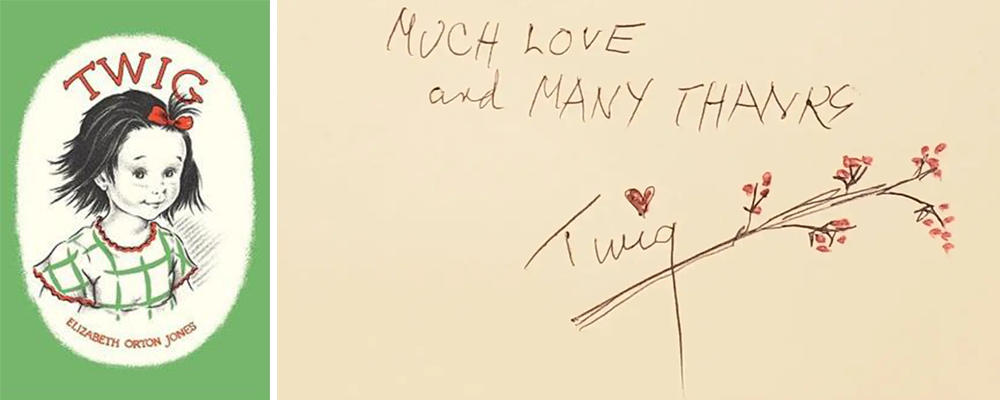In 1944, the year before she won the prestigious Caldecott Medal for children’s book illustration, Elizabeth Orton Jones visited Mason, New Hampshire on a business trip to meet with author and friend Gladys Adshead, for whom she was illustrating the book What Miranda Knew. Besotted with the picturesque landscape of the town, she purchased an old farmhouse with twenty acres of land near Gladys’s home on Valley Road. Here she would live for the rest of her life, becoming one of the community’s most beloved figures.
The house, which Jones described in a remembrance she wrote for Horn Magazine, was purchased with the first royalty check she received for Twig, published in 1942. The only way she could acquire the property as an author-artist “was by way of its being sold for taxes and having no claims to grandeur whatsoever: no water, no electricity, no heat, no telephone.” She and her sister set about to make the house habitable using “plenty of elbow grease” and the “pioneer blood” stirring in their veins. She named it “Misty Meadows.”
In a recorded interview, Jill Morgan of Purple House Press, shares that a royalty check for $2,000 that Jones received for Twig, was followed by similar amounts for Big Susan, published in 1947 and the 1948 Little Golden Books edition of Little Red Riding Hood which she illustrated. With these financial resources in hand, Jones renovated Misty Meadows and when that house became “too cluttered” purchased a second property down the road, which she named “Rock-A-Bye.”
According to Morgan, Jones “saw magic in everything” including the world of childhood and nature. Her nickname “Twig,” adopted from the plucky title character of the book which provided the resources to purchase Misty Meadows, refers to not only a child but also a small and fragile part of a tree. Jones would be known as “Twig” for the remainder of her life and known in Mason solely by that moniker.
Dedicated to researching, recording, and preserving the history of her adopted hometown, Twig was one of the founders of the Mason Historical Society in 1968. She taught history in the local schools; wrote historical pageants and plays; taped oral histories of the town’s elderly residents; compiled a biography of Samuel Wilson, a local character who was the model for Uncle Sam; worked to preserve Mason’s historic burying grounds and both edited and contributed to the commemorative publication, Mason Bicentennial, 1768-1968.
As part of her extensive research on the lost stories of Mason, Twig originated the idea to create a statue on Mason’s town green of Bode, an enslaved young boy who, beginning around 1735, tended cattle by himself for seven years on Nose Meadow in what is now Mason’s village center. While the story of Bode is included in several town histories of Mason, the text included in the Bicentennial publication attributed to Twig wonders what he, as a child, was thinking as “the sole inhabitant of what is now Mason, all summer long, under the stars at night, in the midst of storms, thunder and lightning and pouring rain.” The proceeds from the sale of her estate supported the creation of the statue, and it was dedicated in her honor in 2008.
As a long-standing dedicated volunteer of Andy’s Summer Playhouse, a children’s theater founded in Mason in 1971 by teachers Margaret Sawyer and William Williams, Twig wrote plays for the children to perform and used her artistic talents to design costumes and scenery for the productions. Her contribution to the theater is described as of vital importance to its artistic growth where she “generally inspired every child that she came across.”
Elizabeth Orton Jones was born in Highland Park, Illinois in 1910. The eldest of three children, she grew up in a creative household filled with music (her father was a violinist and her mother a pianist and writer), reading aloud and encouragement to think independently, draw and imagine. She described her household as welcoming to people from various walks of life and nationalities, themes that permeate her books for children.
She received a degree in Philosophy from the University of Chicago and studied briefly at the Art Institute of Chicago. Traveling to France, Jones studied painting at the École des Beaux Arts in Fontainebleau and at the Académie Colarossi in Paris. Upon her return, “Four Seasons” a solo display of color etchings of French children was displayed at the Smithsonian Institution and in 1937, Jones wrote and illustrated her first book, Ragman of Paris and His Ragamuffins.
Author of seven books and illustrator of sixteen others, Twig remained dedicated to children throughout her lifetime. Early in her career she noted that, “a very strong sense of responsibility to what children are as individuals in their own right became firmly established as an imperative in my life.” She herself remained an individual in her own right, as an artist and independent spirit whose passions transcended time and place. A world traveler, she chose Mason, New Hampshire for her home becoming both a steward of its past and treasured member of the community.
In her 1945 acceptance speech for the Caldecott Medal, Twig said she was reluctant to call herself an artist. ”I think of being an artist as an achievement I may work toward my whole life and even then, not arrive,” she said. ”Though, I would like to be able to say, right out loud to myself on the morning of my 99th birthday, ‘Old girl, you are an artist.'” Elizabeth Orton Jones died May 10, 2015, at the age of 94. The following month on what would have been her 95th birthday, the Mason Public Library renamed its Junior Room, the “Twig Room” in her honor; a scrapbook of Twig memorabilia and original artwork remain on display to this day.


